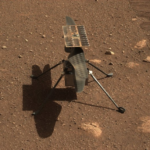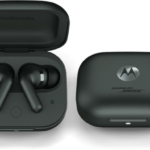
Google has an interesting release cycle with its Pixel lineup. The mainline Pixel devices — currently the Pixel 7 and Pixel 7 Pro — come out in the fall. Then during the following spring, a budget Pixel comes out. Last year, we got the Pixel 6a before the Pixel 7 series, and now we have the Pixel 7a arriving ahead of the upcoming Pixel 8.
Though Google brought about some improvements in the Pixel 7a compared to its predecessor, it also comes at a cost — $150 more, to be exact. Google is keeping the Pixel 6a around for another year, and with a new price of $349, it’s a tempting buy over the $499 Pixel 7a. But is it worth saving a few bucks when the Pixel 7a has so many upgrades? Let’s break it down.
Google Pixel 7a vs. Pixel 6a: specs
| Google Pixel 7a | Google Pixel 6a | |
| Size | 152 x 72.9 x 9mm | 152.2 x 71.8 x 8.9mm |
| Weight | 193.5 grams | 178 grams |
| Screen size | 6.1-inch OLED | 6.1-inch OLED |
| Screen resolution | 2400 x 1080 pixels (429 pixels per inch), 90Hz | 2400 x 1080 pixels (429 pixels per inch), 60Hz |
| Operating system | Android 13 | Android 13 |
| Storage | 128GB | 128GB |
| MicroSD card slot | No | No |
| Processor | Google Tensor Gen 2 | Google Tensor Gen 1 |
| RAM | 8GB | 6GB |
| Camera | 64MP main, 13MP ultrawide, 13MP front | 12.2MP main, 12MP ultrawide, 8MP front |
| Video | 4K at up to 60 frames per second (fps), 1080p at 60 fps | 4K at up to 60 frames per second (fps), 1080p at 60 fps |
| Bluetooth version | Bluetooth 5.3 | Bluetooth 5.2 |
| Ports | USB-C | USB-C |
| Fingerprint sensor | Yes, in-display | Yes, in-display |
| Water resistance | IP67 | IP67 |
| Battery | 4,385mAh
18W wired charging (no charger included in the box) Wireless charging |
4,410mAh
18W wired charging (no charger included in the box) |
| App marketplace | Google Play Store | Google Play Store |
| Network support | Most major carriers | Most major carriers |
| Colors |
Charcoal, Snow, Sea, Coral |
Charcoal, Chalk, Sage |
| Price | Starting at $499 | Starting at $349 |
| Buy from | ||
| Review | News | Pixel 6a review |
Google Pixel 7a vs. Pixel 6a: design and display
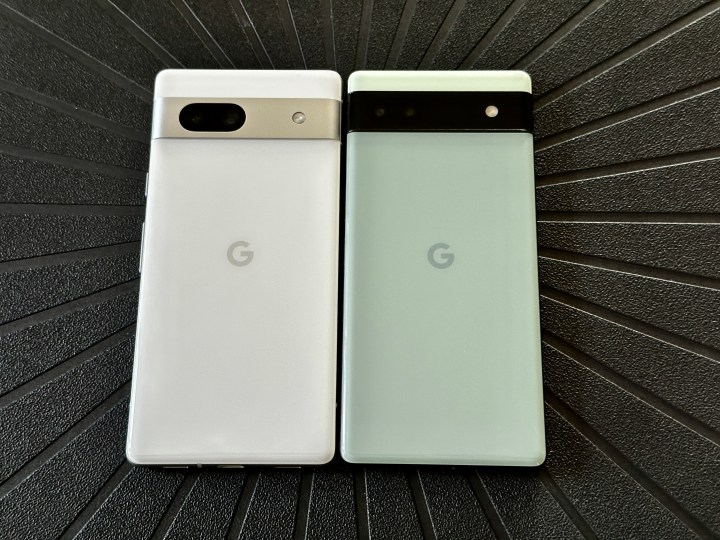
The Google Pixel 6a looks a lot like its bigger siblings, the Pixel 6 and Pixel 6 Pro. However, the design of the body itself definitely lets you know that it’s a budget phone, as it’s mostly plastic. Despite looking like glass, the glossy back is actually plastic, and the frame consists of aluminum with a sleek, anodized black finish. The camera bar is also made with the same glossy plastic material, but there are two thin metal inserts above and below the camera bar, basically extending out from the frame. You can also get the Pixel 6a in three colors: Sage, Chalk, and Charcoal.
The Pixel 6a is also the smallest of the Pixel 6 series, as it measures just 152.5mm tall and weighs 178 grams. In our Pixel 6a review, Mobile Editor Joe Maring said that the Pixel 6a is more comfortable to use than the regular Pixel 6 and Pixel 6 Pro because of the smaller, more compact size.
The 6.1-inch FHD+ OLED display looks good with its 1080 x 2400 pixel resolution, it has a 60Hz refresh rate and is covered in Corning Gorilla Glass 3 for durability. For $449, the display of the Google Pixel 6a is decent enough. The colors look vibrant, the brightness gets high enough to use outdoors within reason, and text is crisp.
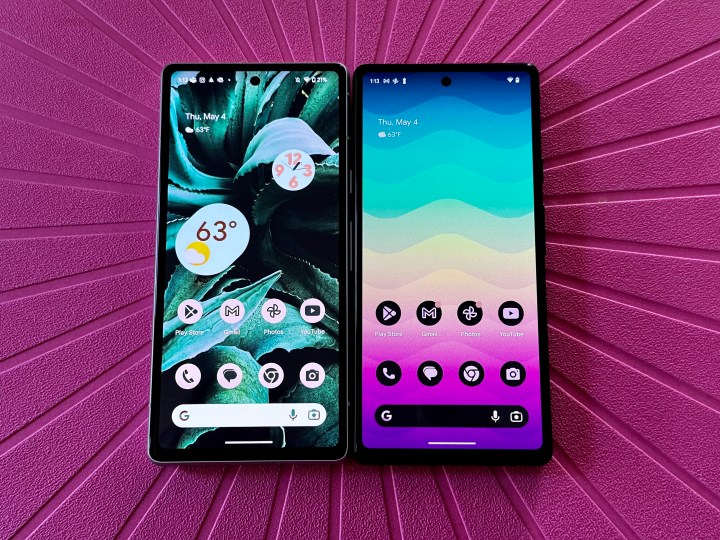
With the Google Pixel 7a, you get a design similar to the Pixel 6a and the Pixel 7. The Pixel 7a also has a high-gloss plastic back and an aluminum frame, though this time, the frame matches up with the color of the device you have — rather than being a consistent anodized black finish. The Pixel 7a comes in four colors: Charcoal, Snow, Sea, and Coral (exclusive to the Google Store, retail and online).
But the biggest difference between the design of the Pixel 6a and Pixel 7a has to d with the camera bar. On the Pixel 7a, the whole camera bar is metal rather than plastic. It’s more in line with the regular Pixel 7 and gives it a more premium aesthetic, despite being a budget device. Google also claims that the Pixel 7a is the most durable A-Series Pixel yet, as it has IP67 water-resistance protection and is scratch-resistant, thanks to Corning Gorilla Glass 3.
The Pixel 7a is also similar to the Pixel 6a in size, with very slight differences. It’s 152.4mm tall and weighs 193 grams. But you still have a slightly better FHD OLED display with up to a 90Hz refresh rate. Though it’s not 120Hz like the Pixel 7 Pro, the 90Hz refresh rate display on the Pixel 7a lines it up with the standard Pixel 7, which is also 90Hz. When compared side-by-side with the 60Hz screen of the Pixel 6a, it’s a noticeable improvement.
Winner: Google Pixel 7a
Google Pixel 7a vs. Pixel 6a: performance and software
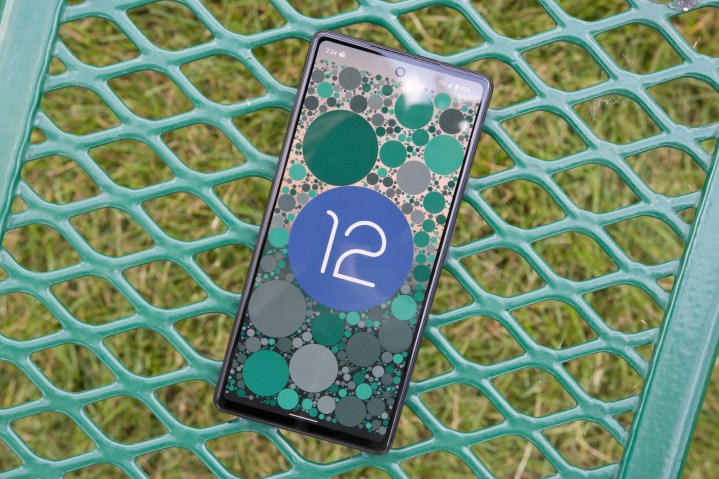
When the Google Pixel 6a first launched, it came with Android 12 out of the box. Since the Pixel 6 and Pixel 6 Pro, Google has promised three years of Android OS upgrades and five years of security updates. With that in mind, the Pixel 6a should last through Android 15 in 2025.
Inside the Pixel 6a, you have Google’s first-generation Tensor G1 chip, along with 6GB RAM and 128GB storage. For everyday tasks — like checking email and messages, social media, web browsing, watching videos and listening to music, and using the camera for photos or video recording — the Tensor G1 chip works perfectly fine. Even if you play Call of Duty or some casual puzzle games, the Tensor chip gives solid performance.
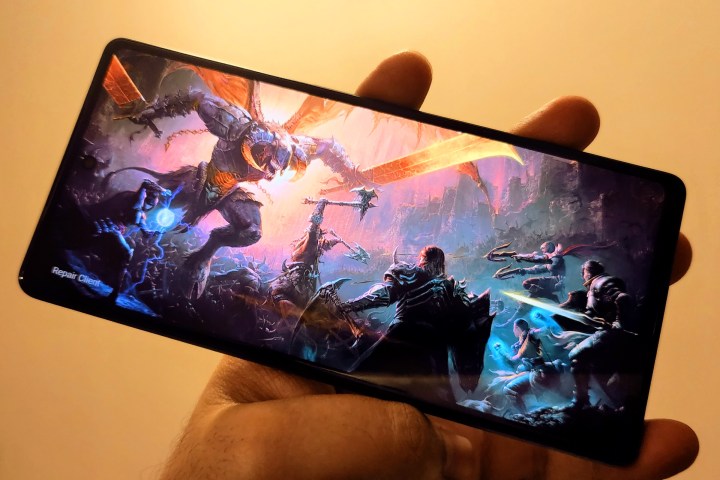
However, one thing we noted in our Pixel 6a review is that the first-generation Tensor chip is not the best at power efficiency. It would get noticeably hot if you’re doing anything resource intensive, like gaming. But unless you’re engaging in gaming sessions for hours on end on the Pixel 6a, you may not have an issue with this.
With the Pixel 7a, you’ll get Android 13 out of the box, just like the Pixel 7 and Pixel 7 Pro. The Pixel 7a has the same promise of three years of Android OS upgrades with five years of security updates. As such, you should expect it to get updates through Android 16 in 2026.

Google also made improvements to the specs of the Pixel 7a. You get the second-generation Tensor G2 chip inside, as well as 8GB RAM with 128GB storage. So even though it also only comes in one storage capacity like its predecessor, the Tensor G2 chip has better performance and efficiency, and when you combine that with more RAM, it’s fast and responsive for the things you need it to do.
The Pixel 7a also brings face unlock, which was a feature that never made it to the Pixel 6 lineup. This adds an extra layer of security when it comes to getting access to the phone, alongside the standard passcode/pattern/password and fingerprint unlock methods.
Winner: Google Pixel 7a
Google Pixel 7a vs. Pixel 6a: cameras
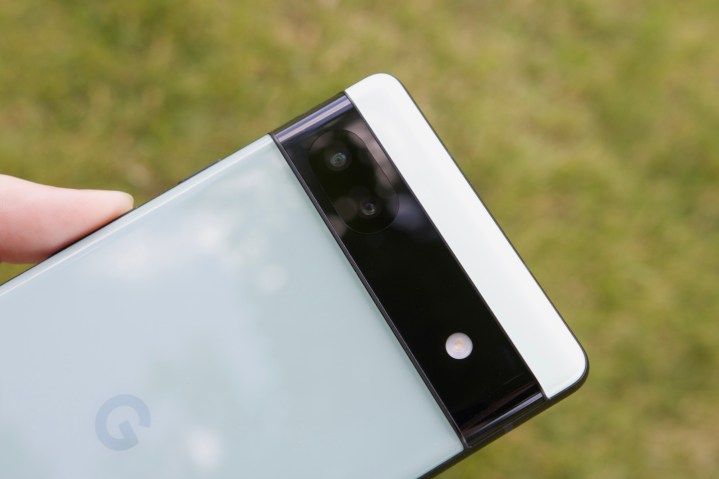
Despite the Google Pixel 6 and Pixel 6 Pro having new 50MP main cameras, the Pixel 6a was stuck with the same 12.2MP camera that had been on Google Pixel phones since 2017. It also has a 12MP ultrawide camera with a 114-degree field of view, as well as an 8MP front-facing selfie camera.
Even though those camera specs don’t sound very impressive compared to what you can currently find on a lot of other smartphones, the Google Pixel 6a has always been a reliable camera phone. In our review, Maring said he could capture photos with great detail and punchy colors that weren’t overly vibrant, as long as the lighting is decent. The HDR functionality also makes it possible for the Pixel 6a to handle challenging skies and other harsh lighting conditions. It’s also quite fast at capturing the moment, thanks to the Tensor G1 chip.
Even the 12MP ultrawide camera with a 114-degree field of view captures good images. The details are a bit softer, but it retains the same color profile as the main shooter. However, lowlight environments are where the Pixel 6a seems to struggle, as Night Sight works to brighten up the scene, but leaves very soft details.
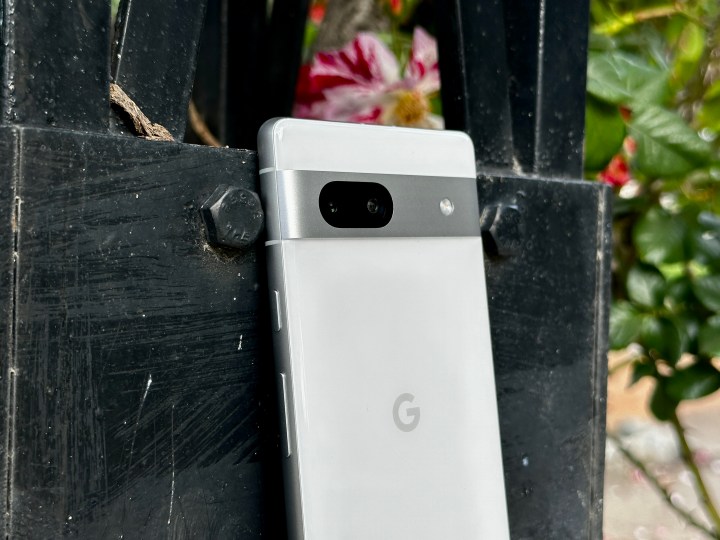
Google upped the ante with the Pixel 7a, as it has the best cameras on an A-Series Pixel yet. Instead of going with the 50MP main camera that is found on the Pixel 7, Google went with a 64MP main camera with an 82-degree field of view and a 13MP ultrawide lens with a 120-degree field of view. The front-facing selfie camera has also been upgraded to a 13MP lens with a 95-degree field of view.
You may be wondering why the budget-friendly Pixel 7a has a higher megapixel camera than the standard Pixel 7 and Pixel 7 Pro, which are both at 50MP. However, Google states that the standard Pixel 7 series phones still have larger sensors, allowing those devices to capture more light in images, resulting in overall better quality. After all, it’s not all about the megapixel count with photos — it’s also about lighting, which is a sensor matter.
Thanks to the improved camera system, the Pixel 7a takes some amazing photos for the price. Like its predecessor, the colors are vibrant without being overly punchy, unlike most Samsung devices, and images look realistic compared to what you see in reality. Photos still pack in good amounts of detail, and the bokeh effect in portraits is soft and done nicely. It also seems to handle skin tones well, and there’s practically no delay in trying to capture a subject in motion.
We’re still digging into the Pixel 7a cameras for our review, but so far, just by looking at the camera specs, the Pixel 7a is a worthy successor to the Pixel 6a.
Winner: Google Pixel 7a
Google Pixel 7a vs. Pixel 6a: battery and charging
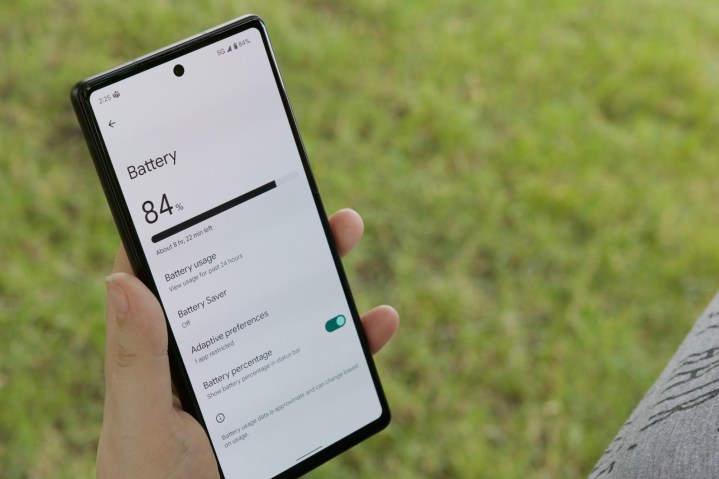
Battery life has been a weak point for the Pixel lineup, and this holds true for both the Pixel 6a and Pixel 7a.
On the Pixel 6a, we have a 4,410mAh battery, which is smaller than the regular Pixel 6 (4,614mAh) and Pixel 6 Pro (5,003mAh). With this in mind, the Google Pixel 6a is pretty much a one-day phone for most people, as you’ll have to plug it in by the time you get to bed. The Google Pixel 6a also caps out at 18-watt wired charging, with no option for wireless charging.
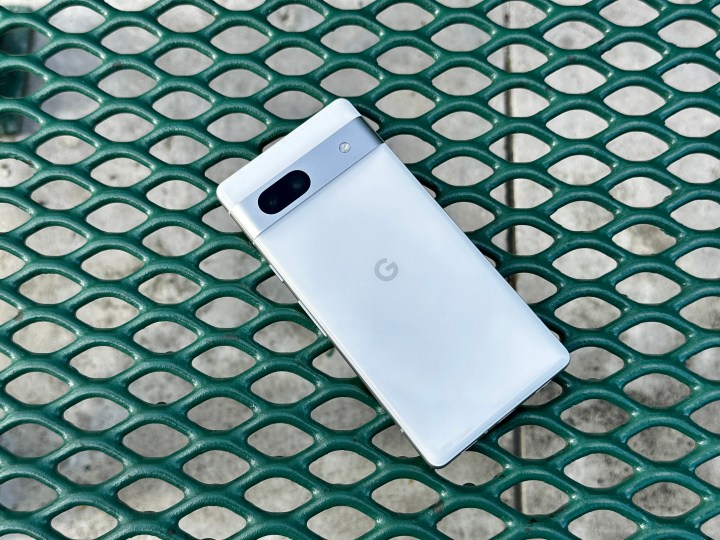
The Pixel 7a isn’t much better on the battery front, at least in terms of capacity. In fact, it actually has slightly less juice at 4,385mAh, so again, it’s another one-day smartphone at best.
Though the Pixel 7a still charges up at the same 18W speed as its predecessor, Google finally added wireless charging to the Pixel 7a. However, that wireless charging speed is pretty slow at only 7.5W. Unfortunately, there is no reverse wireless charging battery share), unlike on the Pixel 7 and Pixel 7 Pro.
Winner: Google Pixel 7a
Google Pixel 7a vs. Pixel 6a: price and availability
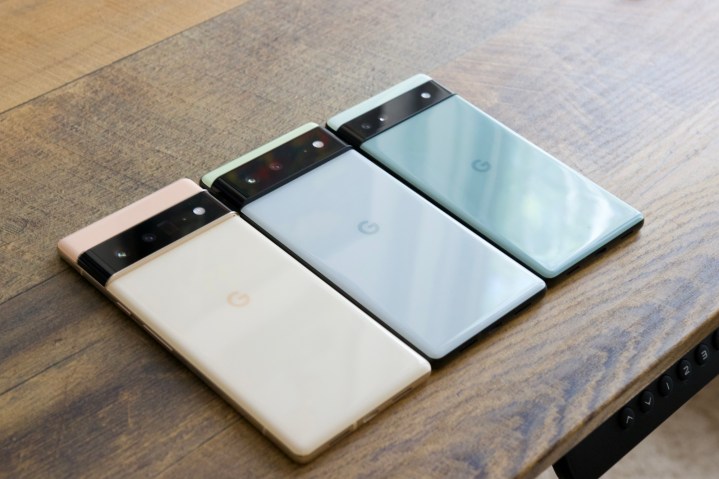
Even though the Google Pixel 6a is from last year, Google continues to sell it alongside the Pixel 7a. With the Pixel 6a, you can get it in three colors: Sage, Chalk, and Charcoal. The Pixel 6a now costs $349 (down from the previous $449 price), which is an incredible value.
The Pixel 7a has a good number of improvements over its predecessor, but that also comes at a cost. The Pixel 7a is $499 and comes in four colors: Charcoal, Snow, Sea, and the Google Store-exclusive Coral.
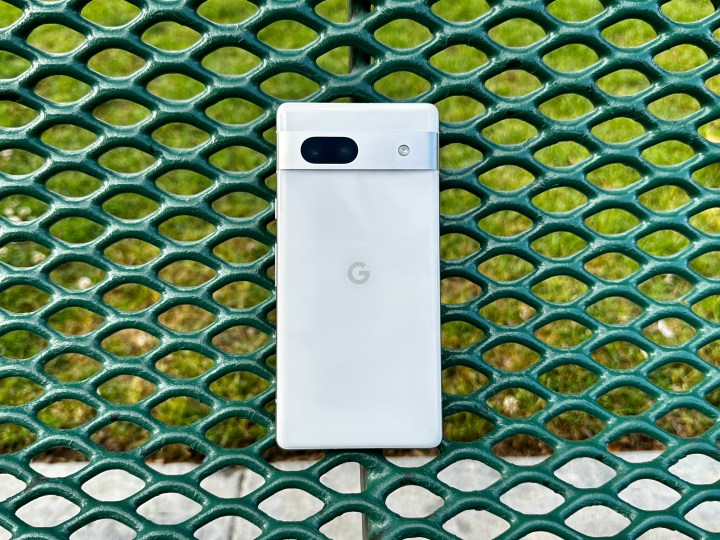
With the $150 price increase, it’s harder to recommend the Pixel 7a as a true budget-friendly Pixel. It’s also in a weird place since the Pixel 7 is just $100 more than the Pixel 7a at $599 and a better overall buy unless you prefer to stick with smaller phones. Sure, Google made improvements with the Pixel 7a — like the 90Hz refresh rate, 64MP main camera, and even wireless charging — but it’s hard to justify buying one instead of even a Pixel 7.
Winner: Google Pixel 6a
Google Pixel 7a vs. Pixel 6a: verdict
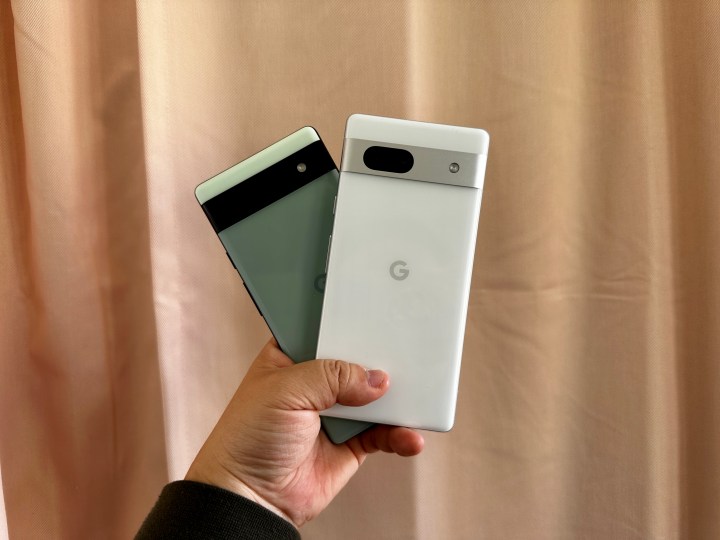
When you’re just comparing the Pixel 6a to the Pixel 7a, the Pixel 7a is mostly better in terms of specs. The display has been improved from the original 60Hz to 90Hz refresh rate, the cameras make a massive jump from 12MP to 64MP, the Tensor G2 chip is better, and the RAM is now 8GB instead of 6GB. And though its wireless charging isn’t the fastest on the market, it’s still an option that wasn’t available on the previous model.
Everything is clearly an improvement except the price. If you want a budget-friendly Pixel phone, then the Pixel 6a is still the better option, especially with the new price drop. The Pixel 7a is technically a better smartphone, but is it $150 better? For most people, we’d argue that it isn’t.
And if you do find yourself tempted by the Pixel 7a’s upgrades, it may also be better to just consider a regular Pixel 7, which is just $100 more than the Pixel 7a at $599. Though the camera is only 50MP, the Pixel 7 still has larger sensors, which help in low light situations, the battery is slightly better, and you have reverse wireless charging too.
Editors’ Recommendations

